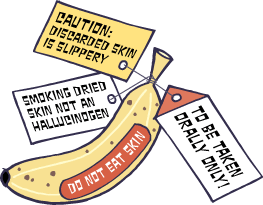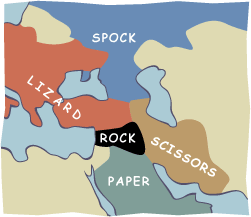2016 July-Dec
Caution: Warnings Ahead

Did Santa bring you what you hoped for this Christmas? Did he forget the batteries which were not included? Hey, it probably warned as much on the package. Or did you get something that didn’t need batteries but did have one of the following real warnings on actual products?
- For decoration only and will not prevent you from any bodily harm or injury. (Bicycle helmet decals)
- For accessory use only. Not to be used as a battle device. (Star Wars lightsaber)
- Remove child before folding (Baby stroller)
- Do not drink (Printer ink)
- Warning! Cycling can be dangerous. Bicycle products should be installed and serviced by a professional mechanic. Failure to heed any of these warnings may result in serious injury or death. (Bicycle handlebar bell)
Are people really that stupid? We doubt it. More likely these warnings exist because litigious lawyers are really that weaselly.
This site intended for entertainment purposes only and does not constitute life advice. Before taking any of it in part or whole to heart contact your local minister, rabbi, guru, psychiatrist, commissar, or parole officer.
Filed 12/27/16
The Official Word From One Sour Kraut

Professor Frank N. Bienz explains the world situation to the Sucksters (not shown) in 1997 or thereabouts. I don’t know why, but this spot always makes me smile even though I have no idea what the heck it was supposed to be about. If you have a similar reaction, consider it my Boxing Day gift to you, keeping in mind nobody expects much in a Boxing Day gift.
Filed 12/26/16
Ah-h-h-h-h, Winter

Winter arrived for its annual visit at about 5:00 this morning. Did you feel it? If not, try going outside. Without a coat. Which might not help depending where you live. The holidays are fast approaching and we all know what that means: Lists.
Shopping lists, wish lists, naughty lists, nice lists, best of the year lists, worst of the year lists, New Year’s resolution lists, prediction lists, lists of lists. And coming soon to a web device near you, our annual “Not Done” list.
Without lists modern life would not be possible. We mean lists like indexes, tables of contents, appendixes, directories, menus, sub-menus, sub-sub-menus, and so on. We simply couldn’t manage modernity without lists. We at terry colon dot com have a hard time managing with them.
By the way, that “Ah-h-h-h-h” in the headline is not said the same as an “Ah-h-h-h-h” we say for summer. More like an “Ah-h-h-h-h” we’d say if our computer crashed. But not so much like an “Ah-h-h-h-h” we’d say if we crashed our car into a Mack truck. It’s all in the inflection as “Ah-h-h-h-h” doesn’t have a definite meaning. Interjections just sort-of work that way.
Filed 12/21/16
Rerunning Gag

Offissa Pup chasing Flatop who’s just committed an intellectual property theft. The irony is they are copyrighted characters and this is art taken from Suck.com and so maybe I’m guilty of the same.
OK, some people will say that’s not really what ironic means. Well, that’s the way most folks use the word and I’m not going to swim upstream against the tide of half a billion English speakers, to mix a metafor. Besides which, what is the word that means what it is I’m using ironic to mean in that case? I dunno. If nobody else can tell me it’ll just have to do.
Filed 12/17/16
Our Post-Modern-ish Calendar Reform

Odd how the seven day week came from the Bible while the names of the days are all pagan. It does make us wonder, when did non Jewish/ Christian/Muslim countries fall in with this seven day week business? Was there a seven day week in the Han Dynasty? Did ancient Hindus or Aztecs have a seven day week? Or a week of any length, for that matter? Did pre-Christian Romans only divide months in halves, were the Ides their version of a weekend?
Anyway, the day names are not even consistently anything. Four Norse gods, one Roman god and the sun and the moon. Maybe they should all be modernized to be more relavent for today. Wednesday could be Humpday for instance. Saturday might be called Funday. Sunday, which starts the week, could be dubbed Oneday. Which turns Monday into Twoday. Though if one day Oneday were today, Twoday would be tomorrow. That won’t work.
Maybe we could go Alphabetical. Aday, Bday, Cday, etc. That’s pretty bland, so maybe we could use the Greek alphabet, Alphaday, Betaday… uh… who knows the Greek alphabet besides the Greeks? Perhaps the days shouldn’t be named after anything or anyone but be totally contrived, like modern brand names that vaguely sound like something meaningful. Beginning on Sunday the week might become Rilaxday, Bactwirkday, Blazzāday… Hm-m, reckon we can forget about that lucrative career concocting novel names for the Big Three.
On the other hand, if we were radical about separation of church and state we should get rid of the seven day week altogether. It’s from the Bible after all. People shouldn’t be paid extra for working Sunday, that’s a Christian Sabbath thing, right? We could possibly decimalize the week, ten days. But that makes an eight day work week. Too long.
Perhaps we could take our cue from the calendar, base twelve, a twelve day week. Nah, a ten day work week sucks more than an eight day one. What if we divide a month by twelve? That renders a 2.5 day week, which is ridiculous. Let’s try base six instead. A five day week with a two day weekend. Other than national production sinking like a stone from working only three days a week, we can go for that. Plus, we only need five day names. Rilaxday, Betaday, Humpday, Enday, Funday. There, problem solved. You’ll thank us Oneday.
Filed 12/13/16
What Time Is 17:=U?

The clock on my range (stove if you will) reads: “17:=U” Huh? There’s one bugaboo with digital readout clocks of the LCD variety. When some of the liquid crystals, or whatever, start to fail it makes for a pretty lousy clock.
I say for a lot of things analog dials and nobs (or pots as some call them) are just better. Old fashioned clocks with hands are one case. The display has meaning without having to read it or say in your head, “ten forty-five.” The minute hand pointing straight left tells you it’s fifteen to the hour at a glance. This is very handy because many times you know what hour it is so you really only need to know the minutes.
Things like analog tachometers have a similar advantage. You don’t really need to read the numbers to see the engine is revving at the redline. With a digital readout you have to remember what the redline number is to make sense of what a numerical readout is indicating. Plus, a needle on a dial isn’t quantized at number points, you get zero to whatever and everything in between.
Thing is, a dial shows you relationships, where the needle is along the entire spectrum. Heck, an illiterate can make sense of that sort of indicator. If the needle is pegged one way or the other you know there ain’t no more of whatever-it-is to give. You don’t always get that with a digital readout. It’s sort-of like a map where X marks the spot so you can tell where you are related to the surroundings, whereas a couple of coordinate readings might leave you baffled.
Volume controls are much better as knobs. OK, much quicker, at any rate. You can turn the volume up or down fully in a fraction of a second, no delay in waiting for that up or down button to cycle through the levels. On the other hand a digital button might be more precise, or at least easier to hit the exact level you want. In the same vein, a digital readout timer is a better option, being easier to set with precision. A digital readout stopwatch also makes the grade for similar reasons. As does a thermostat.
Be that as it may, a lot of analog clocks don’t even have numbers on them and we can still tell the time. Anyway, dials just simply look better, they have an esthetic appeal those clunky, blocky digital readouts invariably lack. I mean, how many different typefaces do you get with an LCD readout clock? I rest my case.

The last challenge, what time was 17:=U ? 10:30, 10:50, 10:28? Who knows?
Filed 11/29/16
If It’s Not Big and Not Little, What Is It?

Do we really need so many adjectives for size? On the one hand we have big, colossal, enormous, gargantuan, giant, gigantic, ginormous, great, huge, humongous, immense, jumbo, large, mammoth, mega, monumental, massive, titanic, and whopping. Not to mention economy-sized, family-sized, king-sized, man-sized, and Brobdingnagian.
On the other hand we have half-pint, itsy-bitsy, itty-bitty, little, little-bitty, micro, mini, miniature, minuscule, minute, nano, peewee, pint-sized, small, teensy-weensy, teeny-tiny, teeny-weeny, tiny, and wee. Not to mention dwarfish, midget, pygmy, puny, and Lilliputian.
Note how we double up words to make things even smaller or bigger. Itty-bitty, teeny-tiny, or, going the other way, great big, big huge, or even great big huge jumbo jet.
Still, we don’t seem to have a specific word for something that’s not big or little. Words like average, medium, middling, moderate, normal, and standard don’t specifically refer to size. All we get are hyphenated terms, average-sized, medium-sized, and middle-sized. Hm-m-m.
In clothing we have small, medium, large, extra large, extra-extra large, and extra-extra-extra large. With all the words we have for big couldn’t we do better than extra-extra-extra large? We could take a page out of the olive sellers book and go with small, medium, large, jumbo, giant, and colossal.
For cars we get full-sized, mid-sized, compact, and sub-compact. There just doesn’t seem to be any big cars. At least not that they admit to. Have you seen the size of some of the SUVs on the road? They seem to be something more than full-sized to us. Compact means close-packed, tightly packed, condensed. Maybe these trucks masquerading as cars could be called the antonym of compact. How about expansive or sprawling? Or our choice, call them bloats. Just a thought.
Filed 11/25/16
Infrequently Answered Questions
World’s Longest Trucks

Q: Why is a big rig truck called a semi? It looks like an entire truck to me.
A: The whole rig is a tractor-trailer with the tractor being something like a railroad locomotive, which actually carries no cargo but provides motive power. As a locomotive isn’t a train unless it’s towing cars one might ask, is the big rig tractor without a trailer even a truck?
So, without a trailer perhaps the tractor is only half a truck, a semi truck. Actually, the term semi comes from the trailer part rather than the tractor part. Normally a trailer is towed and stands on its own front and rear wheels. That would be a full trailer. A trailer that’s supported in back on its own wheels and in front on the tractor is a semi trailer.
Put the bits together and you have a tractor-semi trailer. Which is easier simply to call a semi. Or a big rig. Or call it a truck, we don’t imagine truckers really care what the public calls them.
Big rigs can also tow full trailers behind the semi trailer. They call this a road train, appropriately enough. The biggest and baddest of these run in Australian, called a body and six. That’s a tractor, one semi trailer and five fully towed trailers. They pretty much only traipse through the outback on long, flat, straight roads with scant traffic. After all, you wouldn’t want to try maneuvering one of these beasties through city streets. Or even backing up for that matter.
The World’s Longest Truck - Road Train in Australia
What you didn’t ask is why truck drivers are called Teamsters. This goes back to the days when the motive power for pulling trailers was a team of horses. We reckon you can figure it out from there.
Filed 11/15/16
The Real Origin of the BMW Logo



Click pick to replay animation
The BMW logo has nothing to do with a spinning airplane propellor as some say. It’s more along the lines of American companies using a star in their logo, it’s a symbol for the location of the company. In BMW’s case, Bavaria.
Thing is, the mistaken information (if something incorrect is information) has made the rounds for decades. I first heard it in the early 1980s, well before the advent of the Internet allowed folks to spread myth-information at lightening speed. Still, the Internet does afford the opportunity to more easily double check this sort of thing. Though it seems fact checking doesn’t happen as often as it might. In the particular case mentioned, I stand guilty as charged.
For you fans of German soccer, you may also note Bayern Munich have sort-of copped the BMW logo for themselves, a circle with stylized Bavarian flag blue and white checks inside. Check it out for yourself. See, the Internet makes research easy. Not that you’ll always find the truth, but you’ll find something. Without having to leave your seat.
Filed 10/7/16
It’s a MAD, MAD, MAD, MAD, MAD World

One map explains it all.
Filed 10/4/16
Tea Kettle Calls Coffee Pot Black

I’ve been going through the video archives of the BCC’s Top Gear. Not that I’m that much into supercars or care about reviews of new cars. Still, I do enjoy the foreign adventures, races, challenges, and such. My favorite, perhaps, is when they tried to kill a Toyota pickup and couldn’t.
Killing a Toyota - Top Gear - BBC
These featured bits seem fairly contrived and probably more scripted than they’d like viewers to believe. Which I suppose they must be, the show is sort-of what you might call comedy-reality TV. One comedy thread that crops up from time to time is the British view of Americans as fat and stupid and Australians as big and dumb. Granted, Americans are the fattest folk on the planet. How big Aussies are I couldn’t say. Still, how accurate is the intelligence part of the stereotypes?
Enter the Programme for International Student Assessment (PISA) which tracks primary and secondary school achievement. The PISA reading score for the UK was 494, the USA score was 500 and Australians scored 515. Interestingly, European-Americans (which includes British-Americans) scored 525, higher than every European country except for Finland.
There’s more: Canada scored 524 and New Zealand scored 521, joining the U.S. and Australia in outdoing the UK. Which suggests the smarter Brits emigrated leaving laggards behind in the mother country. Oh yes, Ireland scored a 496. Meaning the poorest performing English-speaking country is the UK. So, if Yanks and Aussies are as dumb as the Brits joke about, the joke’s on them as they’d be just a little bit dumber.
Another Top Gear running joke is how American cars are rubbish compared to European cars. On this they have a point. American car suspensions are retrograde technology and interior appointments are cheesy plastic. Still, considering how the vast majority of people use their cars, is all that superior fit, finish and high-speed handling worth it? Maybe Americans prefer to spend their resources and brain power on other things.
After all, while Europe was fiddling with incremental improvements of 19th century technology, the automobile, America busied itself inventing personal computers, communication satellites, and the Internet. So, Top Gear presenters, who’s looking dumb now?
Filed 9/28/16
Glass Is No Liquid

When Scotty helped the 20th century engineer concoct transparent aluminum in Star Trek IV I chalked it up to sci-fi imaginariness, like transporters. Regular readers know transparent aluminum really exists. Not only that, they can make other transparent metals, too. Seems strange something so solid and opaque like metal could be made transparent and still be solid. Until you consider glass is made of sand, which we don’t give a second thought to being clear.
Some might say, “Ah, but glass is actually a very viscous liquid and not a solid.” Maybe you’ve heard that one. Well, that’s yet another science myth. Some folks reckoned such when examining Elizabethan (and the like) windows which were thicker at the bottom and concluded they flowed very slowly downward over time. Like super slow, stiff Jell-O or something. Anyway, they figured wrongly.
In the olden days they didn’t make rolled plate glass, float glass. They manipulated glass the old fashioned way, same as glass blowers do today. One window pane making method was spinning a blob of molten glass at the end of the pipe into a flat disk with centrifugal effect which they cut rectangles out of for windows. That’s where the old bull-eye glass you sometimes see in old buildings came from.
A second method was to blow a cylinder, like a vase or tumbler. While it was still molten they’d lop off the end connected to the pipe. Then they’d slit the resulting tube open along its length unrolling it into a flat rectangle.
As you can imagine, neither method guaranteed uniform thickness. When they framed this type of glass for windows they put the parts with the same thickness together at the bottom. Probably just made it easier to make the leading or frame that held it all together. Thing is, there are cases in very old buildings where the glass is thicker at the sides or even at the top. The glass didn’t flow sideways or upwards, the panes were that way from the git-go. The bottom line, glass is a solid and not a liquid.
To make stained glass they added different metals to the glass which produced different colors. Of course, you don’t see teeny-tiny bits of these metals embedded in the glass, it’s all transparent. Or translucent, anyway. Which means transparent metals have sort-of been around quite a while.
Filed 9/17/16
Crazy Inverted Homes



Click pic to replay animation
In a world where they erect bridges to nowhere and build cities nobody lives in, it seems no construction is too pointless not to be imitated by folks hither and yon.
Flip This Home! 10 Unbelievable Upside Down Houses
People do live in some of these inverted structures, so the inside is right side up. Others are furnished and outfitted totally upside down inside. In which case we recommend you not try the plumbing.
Still, if you’re going to do this inverted house folly fully, bury the house so only the basement is above ground. All the same, couldn’t you simply put in a reflecting pool for a similar effect?
Filed 9/12/16
Infrequently Answered Questions
Keeping Descriptions in Order

Q: What’s big and red and eats rocks?
A: A big red rockeater.
Yes, an old gag you might recall from childhood. Yet notice, it’s a big red rockeater and not a red big rockeater. It’s also a grumpy little old man and not an old little grumpy man. To follow the train of thought, which of the following sounds right?
One of those ugly little day-glo English police cars.
One of those English day-glo ugly police little cars.
Though the adjectives are the same in both cases, the second sentence just sounds wrong, even illiterate. That’s because there’s a rule of syntax English speakers use without ever formally learning that such a rule exists. Which is, adjectives generally appear in this order: opinion-size-age-shape-color-origin-material-purpose noun. At least, according to one source. A second has it: quantity-opinion-size-temperature-age-shape-color-origin-material noun.
Whatever the case, you can sometimes get away with changing the order a bit. It could be a little old gray-haired man or a gray-haired little old man. You can also have an ugly big green metal box or a big green ugly metal box. Still, you can’t switch adjectives up too much, there’s no such thing as a metal big green ugly box.
Then again, if you’re keeping inventory you’d pretty much put everything in reverse order, including putting the noun first. The noun is the real gist of the item so you organize and alphabetize by that. In which case you’d have: box, metal, green, big. Opinions of its ugliness, being subjective, are usually not included.
Filed 9/8/16
Writing a Hit Pop Song Is Simple, But Not Easy

The standard western musical scale is an octave, that’s eight notes. Though the scale begins and ends on the same note, as in do-re-mi-fa-so-la-ti-do. That second do is double the harmonic vibration of the first do, so it is and isn’t the same note. Or something. It’s a vibrations per second thing we won’t go into. Though one wonders if we divided time a little differently so a second was a bit longer, would all music be out of tune?
Anyway, toss in flats and sharps, which are the same notes depending on the particular scale, and you get thirteen notes, or twelve since you’re repeating yourself once you close the scale at the upper end. Either way, you still call it an octave and not a trideskitave. All the same, you get more than thirteen (or twelve) scales out of all that because there’s major, minor, diminished, flattened fifth scales and such.
As you can imagine the number of chords and progressions is quite large. Yet, if you want to write a hit pop song you can throw out all that because you don’t need most of it. That’s because every hit pop song uses the same four chords and progression. Don’t believe it? Listen and maybe laugh:
Axis of Awesome - Four Chord Song (with song titles)
As you can see, writing a pop song is simple. In construction. Writing one that’s a hit, not so easy.
Filed 8/30/16
The Best Selling Motor Vehicle of All Time


Depending how you define “best selling” you could make the argument the Ford Model T would top the list. In its heyday this single car had a fifty percent market share, half the cars on the American road were Model Ts. Try outselling that. It wasn’t the top selling in total numbers, but there were a lot fewer people around back then.
By volume the Volkswagen Beetle wins the title of best selling car at over thirty million units sold. Of course, unlike the Model T, it sold all over the world in a much more populous world. It helped that they built the thing for about forty years, more than twice as long as the tin Lizzy.
Still, the VW doesn’t get the crown as the best selling motor vehicle of all time. Notice we said motor vehicle and not automobile. At over 80 million units sold, the winner is… the Honda Cub. That’s right, the ultimate people’s car is a motorcycle. Or is it a scooter? Or, with its large, narrow wheels a sort-of cross between the two? Whatever it is, it’s the king of the road.
Filed 8/23/16
Infrequently Answered Questions
You Can Wallpaper These Paper Walls

Q: Paper or plastic?
A: Something of a vague question, but for my money it’s paper. Not so much for shopping bags, but for another container, the cardboard box.
Corrugated cardboard is one of the greatest, if least celebrated, inventions of all time. Strong, light, versatile, cheap, ubiquitous. How much damage has been spared goods by shipping and storing in corrugated cardboard? How much time, energy and space has been saved by replacing wooden crates with cardboard boxes? Forget plastic, corrugated cardboard is the modern wonder material.
I came across the following and figured there wasn’t much I could say about the wonderfulness of cardboard to beat it, they’re making houses out of the stuff. I’m not talking about the homeless sleeping in cardboard boxes, real homes.
This Tiny Cardboard Home Takes Only 1 Day To Build & Lasts 100 Years
Folks like to make claims about things that haven’t proved out yet, so you’ll understand if I don’t take the “lasts 100 years” as fact. Remember Bucky Fuller’s Dymaxion house? How about Thomas Edison’s concrete house?
For a little backstory on the origins of corrugated cardboard, there’s this from Gizmodo:
How the Cardboard Box Was Invented
Filed 8/10/16